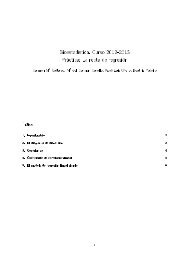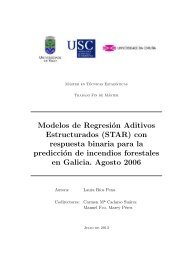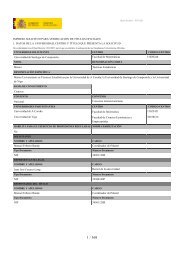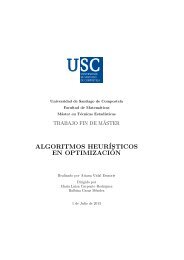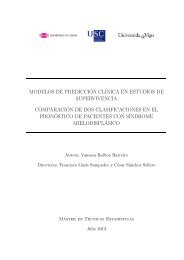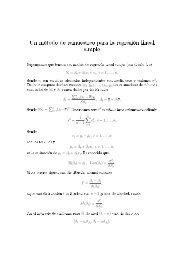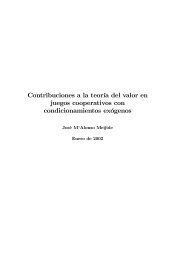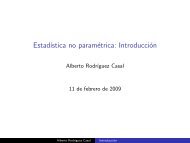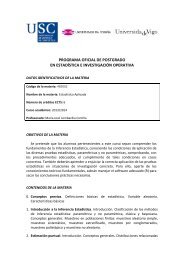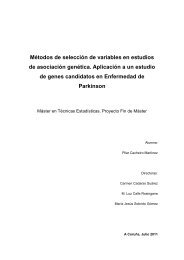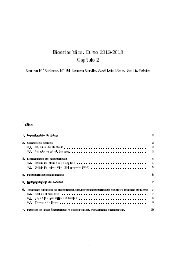Bootstrap independence test for functional linear models
Bootstrap independence test for functional linear models
Bootstrap independence test for functional linear models
You also want an ePaper? Increase the reach of your titles
YUMPU automatically turns print PDFs into web optimized ePapers that Google loves.
Items 1 and 2 in Lemma 1, together with Slutsky’s Theorem, ensure that these three terms convergein probability to 0 a.s.–P , and consequently the convergence in law stated in the theorem is proven.Finally, the convergence of σ ∗2n holds in virtue of items 2 and 3 in Lemma 1.The “naive” bootstrap approach is described in the following algorithm.Algorithm 1 (Naive <strong>Bootstrap</strong>).Step 1. Compute the value of the statistic T n (or the value T n /σ n ).Step 2. Draw {(Xi ∗, Y i ∗)}ni=1 , a sequence of i.i.d. random elements chosen at random from theinitial sample (X 1 , Y 1 ), . . . , (X n , Y n ), and compute a n = ‖TnN∗ ‖ (or b n = ‖TnN∗ ‖/σn).∗Step 3. Repeat Step 2 a large number of times B ∈ N in order to obtain a sequence of values{a l n} B l=1 (or {bl n} B l=1 ).Step 4. Approximate the p–value of the <strong>test</strong> by the proportion of values in {a l n} B l=1greater than orequal to ‖T n ‖ (or by the proportion of values in {b l n} B l=1 greater than or equal to ‖T n‖/σ n )Analogously, let {ε ∗ i }n i=1 be i.i.d. centered real random variables so that E( (ε ∗ i )2) = 1 and∫ ∞0 (P (|ε 1| > t) 1/2 ) < ∞ (to guarantee this last assumption, it is enough that E ( (ε ∗ i )d) < ∞ <strong>for</strong>certain d > 2), and consider the “wild” bootstrap statisticT W ∗n = 1 √ nn∑ (Xi − X )( Y i − Y ) ε ∗ i .i=1In order to analyze the asymptotic behavior of the “wild” bootstrap statistic, the following lemmawill be fundamental. It is a particularization of a result due to Ledoux, Talagrand and Zinn (cf.Giné and Zinn (1990), and Ledoux and Talagrand (1988)). See also the Multiplier Central LimitTheorem in Kosorok (2008) <strong>for</strong> the empirical process indexed by a class of measurable functionscounterpart.Lemma 2. Let ξ be a measurable mapping from a probabilistic space denoted by (Ω, σ, P ) to aseparable Hilbert space (H, 〈·, ·〉) with corresponding norm ‖ · ‖ so that E(‖ξ‖ 2 ) < ∞. Let {ξ i } n i=1 bea sequence of i.i.d. random elements with the same distribution as ξ, and let {W i } n i=1 be a sequenceof i.i.d. random variables (in the same probability space and independent of {ξ i } n i=1 ) with E(W i) = 0and ∫ ∞0 (P (|W 1| > t) 1/2 ) < ∞, then the following are equivalent1. E(‖ξ‖ 2 ) < ∞ (and consequently √ n(ξ − E(ξ)) converges in law to Z ξ ).2. For almost all ω ∈ Ω, (1/ √ n) ∑ ni=1 W iξ i (ω) converges in law to Z ξ .As a consequence, the asymptotic consistency and correctness of the “wild” bootstrap approach isguaranteed by the following theorem.Theorem 4. Under the conditions of Theorem 1, we get that √ nTnW ∗Z (X−µX )(Y −µ Y ) a.s.–P .converges in law toProof. According to Lemma 2, <strong>for</strong> almost all ω ∈ Ω,S ∗ n = 1 √ nn∑i=1(Xwi − µ X)(Ywi− µ Y)ε∗iconverges in law to Z (X−µX )(Y −µ Y ). Moreover (Y w −µ Y ) and (X w −µ X ) converges to 0 (by SLLN).9



